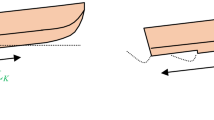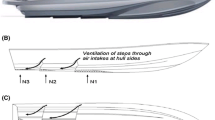Abstract
Recently, Morabito (2010) has studied the water spray phenomena in planing hulls and presented new analytical equations. However, these equations have not been used for detailed parametric studies of water spray around planing hulls. In this paper, a straight forward analysis is conducted to apply these analytical equations for finding the spray geometry profile by developing a computer program based on presented computational process. The obtained results of the developed computer program are compared against existing data in the literature and favorable accuracy is achieved. Parametric studies have been conducted for different physical parameters. Positions of spray apex are computed and three dimensional profiles of spray are examined. It is concluded that spray height increases by an increase in the speed coefficient or the deadrise angle. Ultimately, a computational process is added to Savitsky’s method and variations of spray apex are computed for different velocities. It is shown that vertical, lateral, and longitudinal positions of spray increase as the craft speed increases. On the other hand, two new angles are defined in top view and it is concluded that they have direct relation with the trim angle. However, they show inverse relation with the deadrise angle.
Similar content being viewed by others
References
Green AE (1935). The gliding of a flat plate on a stream of finite depth part I. Mathematical Proceedings of the Cambridge Philosophical Society, 31, 584–603.
Green AE (1936). The gliding of a flat plate on a stream of finite depth part II. Mathematical Proceedings of the Cambridge Philosophical Society, 32, 67–85.
Kihara H (2006). A computing method for the flow analysis around a prismatic planing hull. 5th International Conference on High Performance Marine Vehicles, Tasmania, Australia, 262–272.
Kikuhara S (1960). A study of spray generated by seaplane hulls. Journal of the Aero-Space Science, 27(6), 415–428.
Lattore R, Ryan S (1989). Dimensional and similitude analysis of spray blister sheet from prismatic planing models. Ocean Engineering, 16(1), 71–83.
Locke FWS (1943). A method for making qualitative studies of the main spray characteristics of flying-boat hull models. Davidson Laboratory, Hoboken, United States, Report No. 232.
Morabito MG (2010). On the spray and bottom pressure on planing surfaces. PhD thesis, Stevens Institute of Technology, Hoboken, United States.
Payne PR (1986). On the spray sheet thickness of a planing wedge hull. Ocean Engineering, 13(1), 1–36.
Payne PR (1989). Dimensional and similitude analysis of spray blister sheet from prismatic planing model. Ocean Engineering, 16(1), 71–83.
Pierson JD, Leshnover S (1950). A study of the flow, pressures, and loads pertaining to prismatic vee-planing surfaces. Davidson Laboratory, Hoboken, United States, Report No. 382.
Savitsky D (1964). Hydrodynamic design of planing hulls. Marine Technology, 1(1), 71–95.
Savitsky D, Breslin J (1958). On the main spray generated by planing surfaces. Davidson Laboratory, Stevens Institute of Technology, Hoboken, United States, Report No. 678.
Savitsky D, DeLorme MF, Datla R (2007). Inclusion of whisker spray in performance prediction method for high speed planing hulls. Marine Technology, 44(1), 35–67.
Savitsky D, Morabito MG (2011). Origin and characteristics of the spray patterns generated by planing hulls. Journal of Ship Production and Design, 27(2), 63–83.
Sottorf W (1932). Experiments with planing surfaces. NACA Technical Memorandum, No 739.
Wagner H (1932). Phenomena associated with impacts and sliding on liquid surfaces. NACA Translation.
Zarnick EE (1978). A non-linear mathematical model of motions of a planing boat in regular waves. David Taylor Naval Ship Research and Development Center, Bethesda, United States, Technical Report No. DTNSRDC-78/032.
Author information
Authors and Affiliations
Corresponding author
Additional information
Parviz Ghadimi received his bachelor of science as well as master of science degrees in mechanical engineering from California State University, Long Beach, USA in 1985 and 1988, respectively. He started his PhD studies in Jan. 1989 at Duke University, USA and received his PhD degree in Mechanical Engineering in 1994. He was engaged in 3 years of Post Doc research collaboration under Prof. Knight’s supervision and subsequently joined the Dept. of Mechanical Engineering as a Research Assistant Professor. He then joined Dept. of Mathematics at Duke University as a visiting assistant professor in year 1998 where he served for six years.
Dr. Ghadimi joined the Dept. of Marine Technology at Amirkabir University of Technology (Tehran, Iran) in 2005 as an assistant professor of Hydromechanics and was promoted to associate professor in 2010. He is currently the associate chair of Education in the Dept. of Marine Technology. He has published over sixty scientific articles in international journals and many more in different national and international conferences. He is the author of four books in Farsi language.
Sasan Tavakoli received his bachelor of science in Naval Architecture from Dept. of Marine Technology at Amirkabir University of Technology in year 2013. He is currently a first year graduate student pursuing his Master of Science degree in the field of Hydromechanics. He is currently working on his M.Sc. thesis.
Abbas Dashtimanesh received his PhD in Hydromechanics from Dept. of Marin Technology at Amirkabir University of Technology in 2013. He is currently an assistant professor at Persian Gulf University. His main research interests include numerical methods in hydromechanics, designing and hydrodynamic of planing hulls and dynamics of marine vehicles.
Arya Pirooz received his master of engineering in mechanical engineering from Dept. of Mechanical Engineering at Birmingham in year 2013. He is currently a PhD student of Mechanical Engineering at the International Branch of Amirkabir University of Technology.
Rights and permissions
About this article
Cite this article
Ghadimi, P., Tavakoli, S., Dashtimanesh, A. et al. Developing a computer program for detailed study of planing hull’s spray based on Morabito’s approach. J. Marine. Sci. Appl. 13, 402–415 (2014). https://doi.org/10.1007/s11804-014-1280-8
Received:
Accepted:
Published:
Issue Date:
DOI: https://doi.org/10.1007/s11804-014-1280-8




